Key takeaways:
- Gender equality advocacy requires personal engagement, storytelling, and vulnerability to foster trust and connection within communities.
- Effective platforms for advocacy include Instagram for visual storytelling, Twitter for real-time engagement, and Facebook for building deeper community connections.
- Understanding audience needs and actively seeking feedback is essential for creating impactful content and measuring engagement success.
- Collaborative efforts with local activists can amplify messages and enhance community strength in advocacy initiatives.
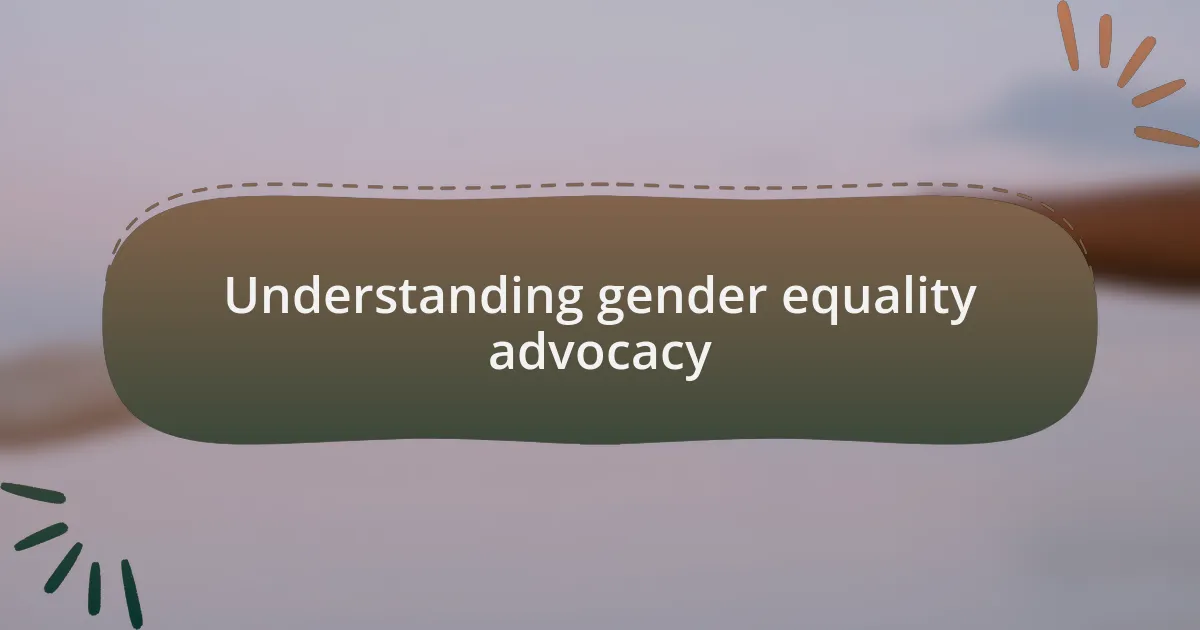
Understanding gender equality advocacy
Gender equality advocacy is not just about promoting equal rights; it’s about fostering a culture where everyone, regardless of gender, can thrive. I remember attending a local event where individuals from various backgrounds shared their stories of overcoming systemic barriers. Hearing their experiences truly opened my eyes to the multifaceted nature of gender issues. How often do we pause to consider the daily challenges faced by women, individuals, and those who don’t conform to traditional gender norms?
The journey towards gender equality can feel overwhelming at times, with societal norms deeply rooted in history. For example, I once volunteered at a shelter for women escaping domestic violence, and the courage I witnessed left a profound impact on me. Each woman’s story was a reminder of the urgent need for advocacy. When we think about the societal expectations placed on genders, we must ask ourselves: what role do we play in challenging these norms?
Moreover, advocacy extends beyond just awareness—it’s about action and solidarity. After reading inspiring articles about young activists, I felt compelled to start conversations within my own community. Have you ever thought about how your voice can contribute to this movement? Gender equality advocacy begins with individuals recognizing their power to effect change, and that realization can spark collective action for a more equitable world.
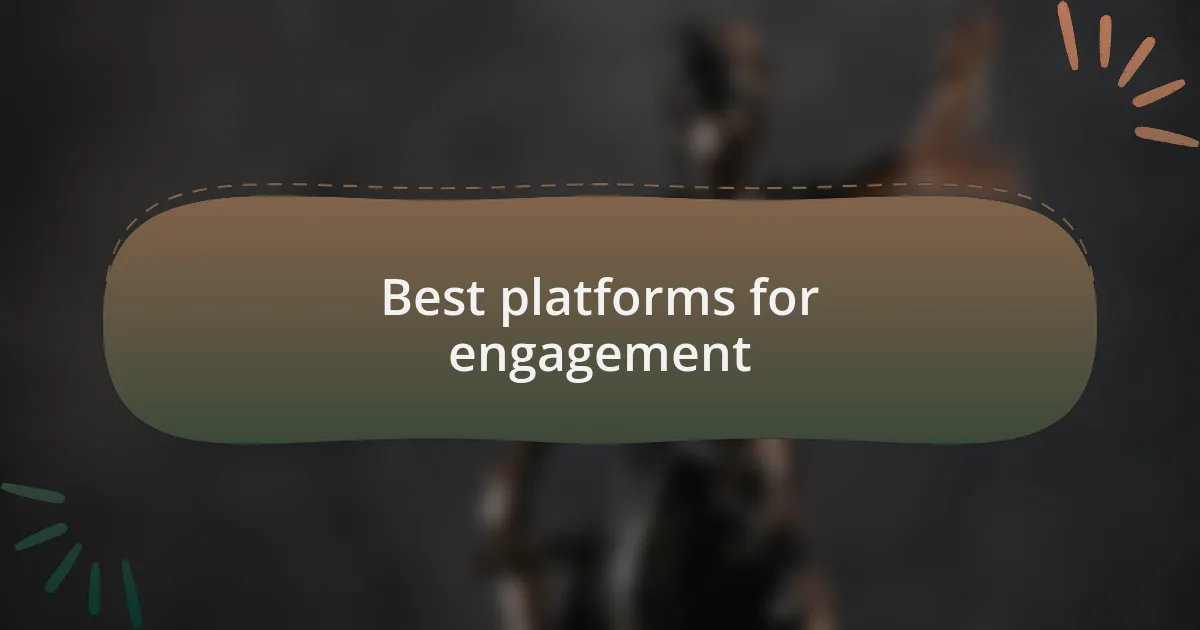
Best platforms for engagement
When it comes to engaging an audience about gender equality, I’ve found Instagram to be particularly effective. The visual aspect allows for storytelling through images and infographics, which can be powerful in conveying messages about equality and justice. I remember posting a graphic that highlighted the gender pay gap; the shares and comments poured in, sparking conversations that continued offline. How can a single post prompt such meaningful discussions if not for the right platform?
Another platform that merits attention is Twitter. Its fast-paced environment is ideal for real-time engagement, especially during awareness campaigns or pertinent global events. I vividly recall tweeting a powerful quote from an activist during International Women’s Day; it resonated widely. The way people retweeted and responded gave me hope, highlighting how concise messages can create ripples of change. Have you considered how brevity can amplify your voice in an age of overwhelming information?
Finally, Facebook continues to serve as a community-building tool, allowing for deeper connections and organized events. I initially hesitated to create a dedicated page for my advocacy work, fearing it would go unnoticed. However, after launching it, I found an incredible network of individuals eager to support and collaborate. The shared experiences of my followers often lead to collaborative projects, emphasizing the importance of community in advocacy. How can we understate the benefits of community connection in our fight for gender equality?
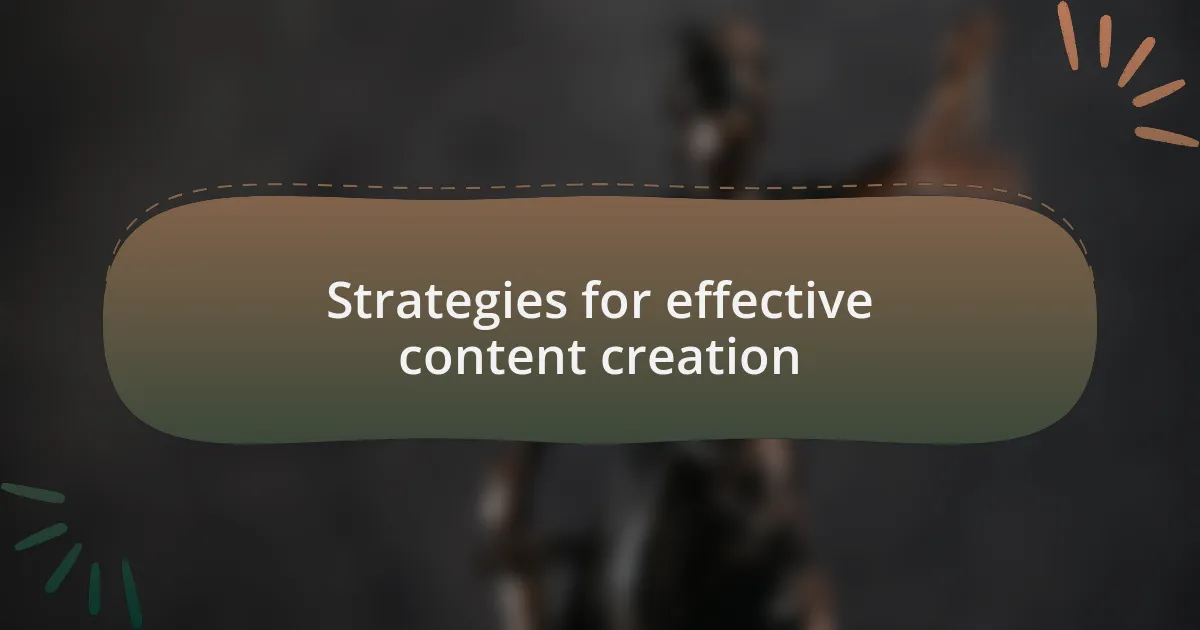
Strategies for effective content creation
Crafting compelling content starts with understanding your audience’s needs and interests. For me, diving deep into the concerns of my followers has often guided my content direction. One time, I conducted a brief poll asking what aspects of gender equality resonated most with them, and I was surprised to find the overwhelming response centered on workplace equality. This eye-opening moment steered my content creation, allowing me to align my messages with the audience’s passions. How often do you check in with your community to ensure you’re on the right track?
Visual storytelling is another powerful strategy I’ve embraced. I remember creating a short video featuring snippets of interviews with local women sharing their experiences. The emotions reflected in their stories not only drew viewers in but sparked an authentic dialogue. The comments section exploded with solidarity and additional perspectives. Have you ever considered how a single visual piece can encapsulate complex issues so effectively?
Lastly, authenticity is crucial in creating effective content. I strive to be open about my journey and the missteps I’ve encountered along the way. Sharing both successes and failures not only humanizes my advocacy but also fosters trust and relatability with my audience. During a challenging campaign, I candidly expressed my frustrations, and the response was overwhelming. People appreciated the vulnerability, and it transformed into a supportive conversation. Have you thought about how vulnerability can create genuine connections in your advocacy efforts?
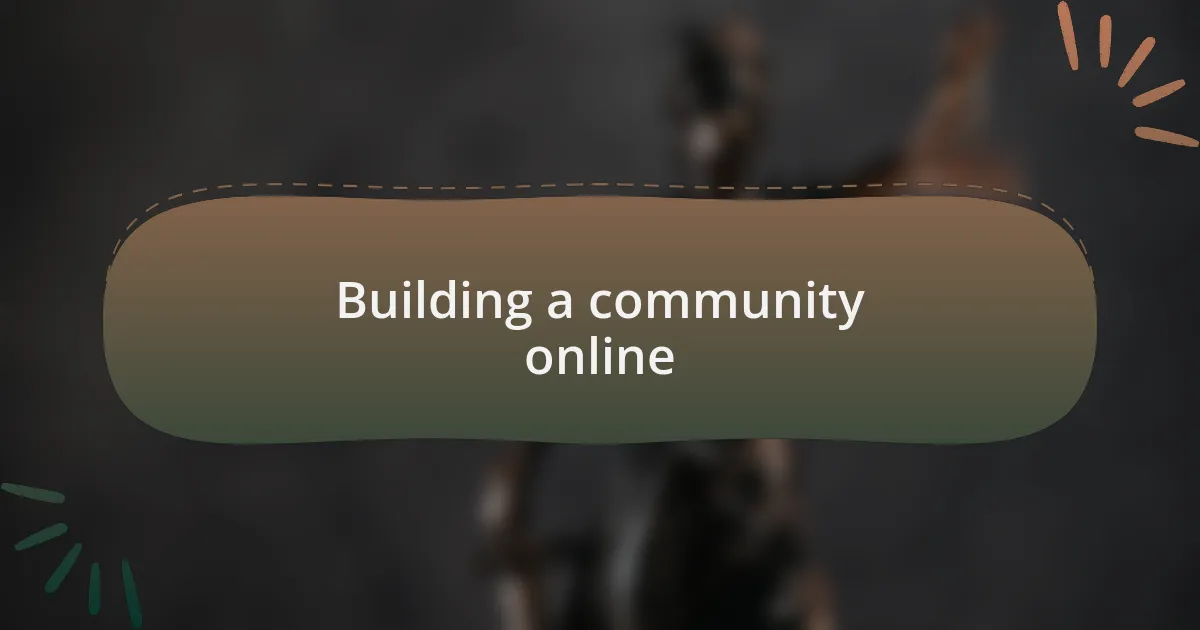
Building a community online
Building a community online requires authentic interactions that foster connection. I recall a time when I hosted a live Q&A session on social media. The energy was palpable as followers shared their thoughts on gender equality, turning a one-way conversation into a vibrant exchange. Have you ever participated in a discussion where you felt truly heard? There’s something incredibly powerful about transforming a platform into a space for dialogue.
Creating opportunities for collaboration also plays a critical role in community building. I once teamed up with local activists to organize a virtual event focused on gender violence awareness. By pooling our resources and reaching out to our respective followers, we attracted an audience that was eager to learn and engage. It was astonishing to witness how shared goals can amplify voices and broaden the reach of our messages. Have you explored collaborations that could enhance your community’s strength?
Finally, it’s essential to nurture the connections that form within the community. I make it a point to regularly interact with commenters and followers, often sending personalized messages of gratitude. When I acknowledged a supporter who had shared their own story, they expressed how much it meant to them. This simple act reinforced our bond and encouraged others to participate more openly. What steps can you take to deepen your connections and create a more intimate online space?
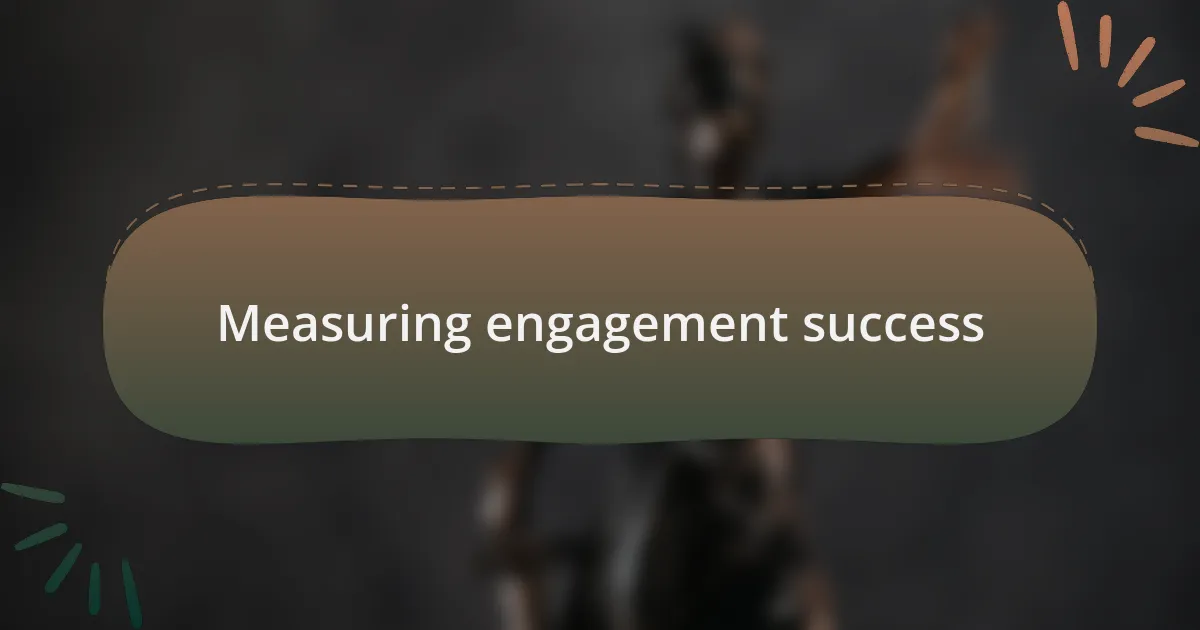
Measuring engagement success
Measuring engagement success can feel overwhelming at first, but I’ve found that it often boils down to understanding the metrics that truly matter. For instance, during my campaign for gender equality, I started tracking not just likes, but the number of comments and shares on my posts. I vividly remember the moment we hit a milestone of a thousand shares on a thought-provoking infographic. It wasn’t just a number; it signaled that our message was resonating and spreading, fueling my motivation to keep pushing forward.
I also believe in the power of qualitative feedback. One time, I encouraged followers to share personal stories related to gender equality in the comments section. The heartfelt responses poured in, and I realized these narratives offered invaluable insight into what resonated with my audience. Have you ever stopped to really listen to the stories that come from your community? These anecdotes not only shape future content but also highlight the real-life impact of our advocacy efforts.
Tracking engagement also means being open to change. I recall a campaign where initial metrics appeared lackluster. Instead of feeling discouraged, I sought feedback and discovered that my audience preferred shorter video content. After pivoting my approach, the engagement dramatically improved. How often do you reassess your strategies based on audience reactions? Embracing this adaptability has been a crucial element in effectively measuring and enhancing engagement success.
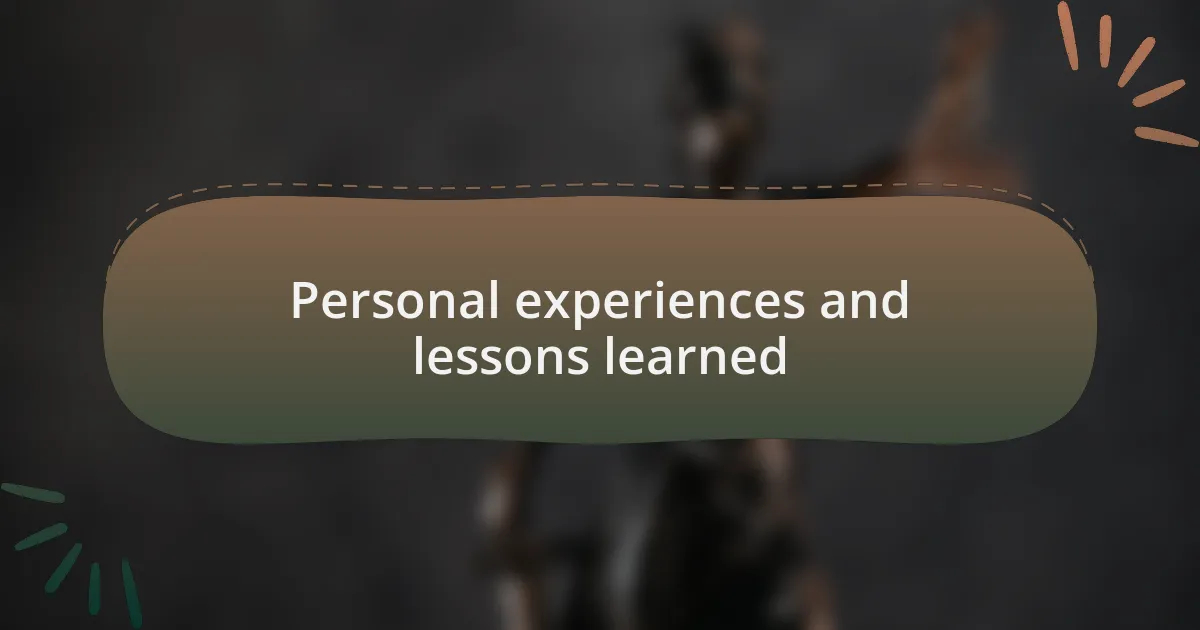
Personal experiences and lessons learned
During my journey in using social media for gender equality advocacy, I learned the importance of authenticity. I vividly recall a post where I shared my own struggles with gender bias in the workplace. The outpouring of support was overwhelming, and it made me realize that vulnerability can spark deeper connections. Have you ever shared a personal struggle and found that it resonated more than you anticipated? This experience taught me that being genuine not only fosters trust but also encourages others to share their stories.
In another instance, I experimented with live Q&A sessions on platforms like Instagram. Initially, I was nervous about this format, fearing it would fall flat. However, the engagement was incredible. It was rewarding to connect with followers directly and address their questions in real-time. This interaction opened my eyes to the power of immediacy and engagement. Have you ever connected with your audience in real-time? It shifted my perspective on communication and encouraged me to prioritize these live interactions as part of my strategy.
I also discovered the value of community building through social media. I started a dedicated group for followers passionate about gender equality, where we shared resources and discussed relevant topics. The sense of camaraderie that developed was heartening, reinforcing my belief in collaboration. It made me wonder, how often do we create spaces for open discussion? My biggest takeaway has been that fostering these supportive environments can significantly amplify my advocacy efforts and foster a sense of belonging.